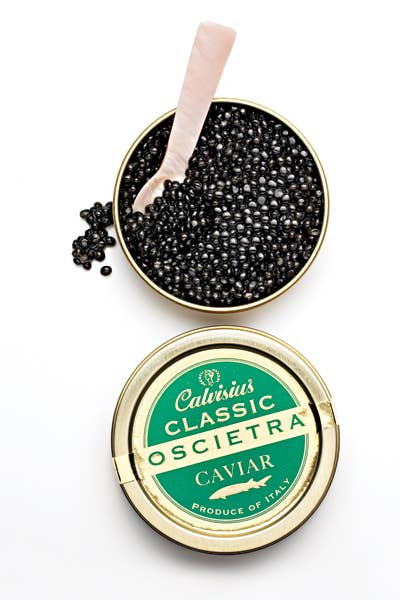
Of all the starters that kicked off my Russian Jewish family's most festive meals, I would always reach for the hard-boiled egg whites filled with red caviar. The treat primed my palate for all types of fish roe. I remember the first time I tasted true caviar (the term for salted sturgeon eggs), an inky constellation on a cracker. That mouthful embodied everything I liked about salmon roe, intensified: the beads were more pungent; they imparted astounding flavor for their tiny size.
The world of caviar has changed dramatically since I was a child. Overfishing, pollution, and poaching have contributed to the severe depletion of beluga, osetra, and sevruga sturgeons from the Caspian Sea, the source of 90 percent of the world's caviar that borders Russia, Iran, and several former Soviet republics. The Convention on International Trade in Endangered Species (CITES) banned the trade of Caspian caviar in 2006 to protect the fish. Though the ban has since been relaxed, Caspian sturgeon are still very much at risk. Where does that leave lovers of true caviar? The answer, it seems, is with aquaculture. Today, reputable vendors of caviar primarily sell farmed varieties. I've tried several—from China, Israel, and the U.S., among other locales—but my favorite is Calvisius Caviar from Italy.
Calvisano, a small town between Venice and Milan, is home to Agroittica Lombarda, the most prolific caviar farm in the world, producing more than 20 tons of eggs each year under the Calvisius brand. Perhaps Calvisius has an edge because of experience: the farm (originally in collaboration with the University of California at Davis) has been raising white sturgeon, a Pacific species valued for its pale flesh and dark, briny roe, since the 1980s, and it produced its first batch of white sturgeon caviar in 1996. (The firm also raises osetra sturgeon and is developing beluga caviar.) Or perhaps it's the conditions: unlike some farms that continually recycle the same water through their fish tanks, Agroittica Lombarda treats its sturgeon to a constant supply of fresh groundwater. The pristine environs are reflected in the flavor of the roe, which is delicious. The white sturgeon eggs are buttery and mild, followed by a clean salinity. Meanwhile, the more complex osetra caviar (pictured at left) reveals rich flavors of walnut and banana. Experts advise that caviar of this quality should be enjoyed unadorned. Yet, I can't help but crave it in an egg-white nest, just as I ate it when I was a kid. An ounce of Calvisius white sturgeon caviar costs $61, and an ounce of osetra costs $89, plus shipping. Visit www.calvisiuscaviar.com.
Keep Reading
Continue to Next Story










